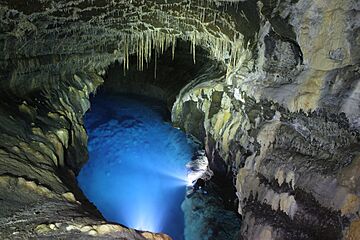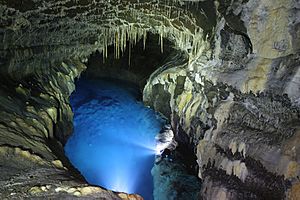Jeju Volcanic Island and Lava Tubes facts for kids
| UNESCO World Heritage Site | |
|---|---|

The Millennium Lake in Yongcheon Cave (2009)
|
|
| Location | Jeju Island, South Korea |
| Includes |
|
| Inscription | 2007 (31st Session) |
| Area | 9,475.2 ha (23,414 acres) |
| Buffer zone | 9,370.8 ha (23,156 acres) |
| Korean name | |
| Hangul |
제주도 자연유산지구
|
| Hanja | |
| Revised Romanization | Jejudo jayeonyusanjigu |
| McCune–Reischauer | Chejudo chayŏnyusanjigu |
The Jeju Volcanic Island and Lava Tubes (Korean: 제주 화산섬과 용암 동굴) is a special World Heritage Site in South Korea. It was chosen by UNESCO in 2007. This site is famous for its amazing Geomunoreum Lava Tube System and many different volcanic features. These features help us understand how volcanoes work around the world.
Jeju is a volcanic island about 130 kilometers (80 miles) from the southern coast of the Korean Peninsula. It is the largest island and smallest province in South Korea. The island covers an area of 1,846 square kilometers (713 square miles).
Contents
Jeju's Volcanic Features
A main part of Jeju Island is Hallasan. This is the tallest mountain in South Korea. Hallasan is a dormant volcano, meaning it is not erupting now but could in the future. It rises 1,950 meters (6,400 feet) above sea level. The main volcano also has 360 smaller volcanoes around it.
Volcanic activity on Jeju started a very long time ago. The most recent eruptions happened about 5,000 years ago. This means Hallasan is considered an active volcano. More study is needed to fully understand it. The island is covered in volcanic rock and soil from Hallasan (한라산). At the top of Hallasan is Baengnokdam (백록담). This is a crater with a lake inside, formed over 25,000 years ago.
Amazing Lava Tubes and Caves
Jeju is very important for science because of its many lava tubes. These are also called Oreum in Korean. A lava tube is a natural tunnel. It forms when hot, flowing lava from a volcano moves under the hardened surface of a lava flow. If the lava inside the tube flows out, it leaves behind a cave.
These caves are great for scientific research. They are also popular places for tourists to visit.
Coastal Wonders
Near the city of Seogwipo, you can find many pillar-shaped rocks along the coast. These rocks show the natural beauty of Jeju. Scientists also find valuable shellfish and animal fossils in this area. Beom Island (Beomseom 범섬) and Mun Island (Munseom 문섬) are also off the coast. They are beautiful and well-preserved areas.
Life on Jeju: Plants and Animals
The wide variety of animal and plant species on Jeju makes it a very important nature reserve. Half of all vascular plants found in Korea grow naturally on the island. Also, 200 other plant species that are native to Korea have been brought here. However, many of these species are now in danger of disappearing.
For example, some polar plants came from the south during an ice age. They now live on the peak of Jeju. Other plants in the subtropical forests and lower parts of the island are also endangered.
Mt. Halla National Park: A Home for Wildlife
Hallasan National Park is in the middle of Jeju Island. Since 1966, any area 800 meters (2,600 feet) above sea level has been a nature reserve. The park is mostly untouched nature. Only hiking paths and park buildings are man-made changes.
The plants in Mt. Halla National Park are very special. So far, 1,565 types of vascular plants have been found here. This is the highest number of plants on any mountain. Thirty-three of these plants are found only on Jeju Island. Unlike most other Korean mountains, Hallasan has plants growing in three different zones: subtropical, temperate, and frigid (very cold) zones.
Many animals also live in the nature reserve. Over 17 types of mammals, 198 types of birds, 8 types of amphibians, 8 types of reptiles, and 947 types of insects have been recorded. Some endangered species include the Capreolus capreolus pygargus and Felis bengalensis manchuria. There are also Indo-Pacific bottlenose dolphins and finless porpoises living near the island.
In the past, large whales like western gray whales and North Pacific right whales used to migrate and rest near Jeju. Now, some pinnipeds (like seals) still visit sometimes. Jeju Island was last connected to the Korean Peninsula about 10,000 years ago. This separation helped unique animals develop on the island. This makes Jeju very important for understanding biology.
A famous part of the Mt. Halla Nature Reserve is the Pillemot Cave. This cave dates back to the Paleolithic period (Stone Age). The cave is important because of the old tools and remains found there. These findings show that people have lived on Jeju Island since the Stone Age.
See also
 In Spanish: Isla volcánica y chimeneas de lava de Jeju para niños
In Spanish: Isla volcánica y chimeneas de lava de Jeju para niños


